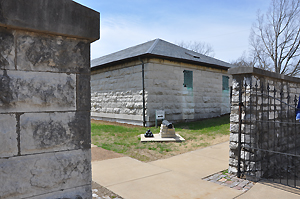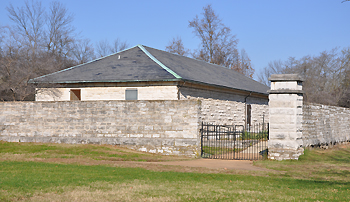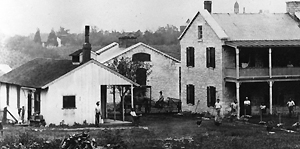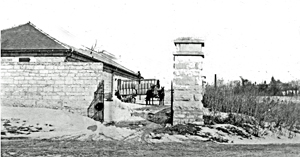Current Exhibit at the Old Ordnance Room
Two Republics; A Look at the Military Interactions Between the United States and Mexico.
United States citizens have been involved in the military history of Mexico since the opening revolts against Spanish Rule. From the Gutierrez-Magee Expedition through the Punitive Expedition led by General Pershing, the military relationship between the two North American Republics has been complicated. Sometimes in conflict, sometimes in cooperation, yet always interesting. Guided tours must be scheduled in advance and require an additional fee. Call 314-615-8882 or 314-615-8884.
Open now until December 31, 2022
Open Wednesday - Sunday, Noon - 4 PM
Jefferson Barracks Park Museums
Two museums housing exhibits, and other historic structures tell the story of life at Jefferson Barracks.
1850's Era Powder Magazines
Museums are open Noon - 4:00 pm, Wednesday through Sunday from March through December. The admission is free but the suggested donation is $3 for adults and $1 for children ages 12 and under. All funds donated helped to continue the exhibit to remain open and be updated.
Powder Magazine Museum
 The Powder Magazine Museum (left), built in 1857, houses the core collection which presents the history of Jefferson Barracks from 1826 to the poresent day. Admission is free however donations are always appreciated. See more about the structure below.
The Powder Magazine Museum (left), built in 1857, houses the core collection which presents the history of Jefferson Barracks from 1826 to the poresent day. Admission is free however donations are always appreciated. See more about the structure below.
 Old Ordnance Room
Old Ordnance Room
The Old Ordnance Room (right), built in 1851, houses temporary exhibits on military themes. Admission is free however donations are always appreciated. Guided tours may be booked in advance by calling 314-615-8882 or 314-615-8884. See more about the structure below.
Volunteer Opportunity as a Museum Attendant
All the historic structures in the park are owned by St. Louis County Department of Parks and Recreation. The Old Ordnance Room and Powder Magazine Museum, along with Laborers House, Ordnance Stable, 533 Grant and the Jefferson Barracks Visitor Center are organized by the Parks History staff. However, the docents that guide visitors in the museums are largely volunteers. Many are members of the Friends of Jefferson Barracks. For information on becoming a volunteer here at Jefferson Barracks contact Tom Hoff at 314-615-8882 or Kelly Plunkett at 314-615-8884. For more information about volunteering in other St. Louis County Parks call Krista Farrow at (314)-615-8865 or visit the St. Louis County Parks Volunteer Page.
Visitor Center
 The building which today houses the Visitors Center for Jefferson Barracks County Park was built in 1878 as a two-level barn for the animals and wagons used by the Ordnance Department. The lower level was made of limestone and the upper level was wood.
The building which today houses the Visitors Center for Jefferson Barracks County Park was built in 1878 as a two-level barn for the animals and wagons used by the Ordnance Department. The lower level was made of limestone and the upper level was wood.
After World War I, the building was used to repair tanks and a stone ramp was built on the west side of the barn in 1925 to access the second floor. Later, during the Great Depression, the building became a storage facility for the Works Progress Administration.
During World War II, it was used as a reception center where families could meet their loved ones who were stationed at Jefferson Barracks.
Jefferson Barracks was de-activated in 1946. Beginning around 1950, the federal government conveyed tracts of land to St. Louis County to operate as an historical park. It was about this time that the upper level was removed. In 1971 Jefferson Barracks County Park, the adjacent active military base, and several other adjoining land parcels were placed on the National Register of Historic Places.
The Friends of Jefferson Barracks (FJB) are a volunteer support group for Jefferson Barracks Park and was organized in 1983.The Friends operate a gift shop on the first floor in the Visitors Center and sponsor many programs and events to raise money to preserve the history of Jefferson Barracks. The Friends could use your support as well. If you would like more information on the Friends and their efforts, call the President of the FJB, John Chapman at 314-615-8880.
Laborers House, Summer Kitchen, Garden, and Stable
Laborers House, Summer Kitchen, Garden, and Ordnance Stable the Laborers House were constructed in 1851 to house the civilian laborers who constructed the buildings in the Ordnance section of Jefferson Barracks. Later it housed the ordnance keeper and his family. At different times a porch or balcony has been a part of the building.
 The summer kitchen can be seen to the west of the Laborers House. In the days before air-conditioning, a summer kitchen was used in order to remove the heat of cooking from the main house during hot weather. By the late 1900s the summer kitchen was eliminated.
The summer kitchen can be seen to the west of the Laborers House. In the days before air-conditioning, a summer kitchen was used in order to remove the heat of cooking from the main house during hot weather. By the late 1900s the summer kitchen was eliminated.
A typical garden of the 1850s might have included herbs and flowers that were essential not only to flavor food, but also used for medicinal applications such as treating fevers to settling upset stomachs. Herbs were also put to use as cosmetics, dyes, cleaners, insect repellants, air fresheners and sachets.
The Stable was built in 1851 to house four horses and two wagons that were used to haul munitions from the St. Louis Arsenal to the ordnance magazines at Jefferson Barracks. The architectural feature of having two doors, so that a wagon could be driven through the stable, is unique.
The Visitors Center, Laborers House, and Stable were built of limestone from a quarry just east of here by the Mississippi River.
Old Ordnance Room Museum
 The Old Ordnance Room was the first of two limestone buildings built in Jefferson Barracks for the purpose of storing gunpowder. It was constructed in 1851 by Master Builder Francis Quinette of St. Louis. The cost, just over $18,000, included the stone wall around the building. Some said that Quinette could not erect a quality building for that amount, but the building remains in use.
The Old Ordnance Room was the first of two limestone buildings built in Jefferson Barracks for the purpose of storing gunpowder. It was constructed in 1851 by Master Builder Francis Quinette of St. Louis. The cost, just over $18,000, included the stone wall around the building. Some said that Quinette could not erect a quality building for that amount, but the building remains in use.
To the south of the museum building, but inside the compound, is a marker designating the area as a Blue Star Memorial By-Way. The marker was presented to St. Louis County Parks by the Mehlville Garden Club on September 12, 2004. The blue star symbol is taken from the World War II service flags that were displayed in thousands of homes during the war. The designation of a Blue Star Memorial By-Way is intended for parks and historical grounds, to commemorate soldiers who served overseas.
Powder Magazine Museum
This is one of the two remaining limestone powder magazines. This structure, which today houses the Powder Magazine Museum, was constructed in 1857. The walls are 4-foot thick limestone with arched ceiling and a wooden floor. If gunpowder exploded, it would take the path of least resistance, blowing through the wooden floor with the concussion causing each arch to fall, smothering the fire. The walls and roof would remain intact, so for all intent and purposes, the building would remain useable.



 The Powder Magazine Museum (left), built in 1857, houses the core collection which presents the history of Jefferson Barracks from 1826 to the poresent day. Admission is free however donations are always appreciated. See more about the structure below.
The Powder Magazine Museum (left), built in 1857, houses the core collection which presents the history of Jefferson Barracks from 1826 to the poresent day. Admission is free however donations are always appreciated. See more about the structure below. Old Ordnance Room
Old Ordnance Room The building which today houses the Visitors Center for Jefferson Barracks County Park was built in 1878 as a two-level barn for the animals and wagons used by the Ordnance Department. The lower level was made of limestone and the upper level was wood.
The building which today houses the Visitors Center for Jefferson Barracks County Park was built in 1878 as a two-level barn for the animals and wagons used by the Ordnance Department. The lower level was made of limestone and the upper level was wood. The summer kitchen can be seen to the west of the Laborers House. In the days before air-conditioning, a summer kitchen was used in order to remove the heat of cooking from the main house during hot weather. By the late 1900s the summer kitchen was eliminated.
The summer kitchen can be seen to the west of the Laborers House. In the days before air-conditioning, a summer kitchen was used in order to remove the heat of cooking from the main house during hot weather. By the late 1900s the summer kitchen was eliminated. The Old Ordnance Room was the first of two limestone buildings built in Jefferson Barracks for the purpose of storing gunpowder. It was constructed in 1851 by Master Builder Francis Quinette of St. Louis. The cost, just over $18,000, included the stone wall around the building. Some said that Quinette could not erect a quality building for that amount, but the building remains in use.
The Old Ordnance Room was the first of two limestone buildings built in Jefferson Barracks for the purpose of storing gunpowder. It was constructed in 1851 by Master Builder Francis Quinette of St. Louis. The cost, just over $18,000, included the stone wall around the building. Some said that Quinette could not erect a quality building for that amount, but the building remains in use.